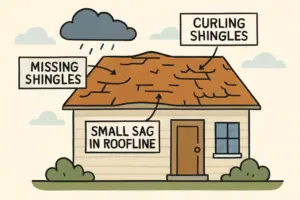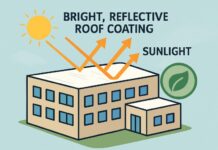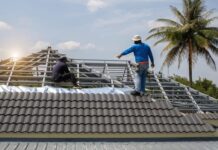Introduction to Roof Replacement
Your home’s roof serves as one of the most critical barriers protecting you, your loved ones, and your property from the unpredictability of nature. Through rainstorms, scorching sunlight, snowfalls, and high winds, your roof takes the brunt of the weather’s impact day after day. Despite their toughness, every roof will eventually reach the end of its serviceable life. Identifying the earliest signs that a roof is beginning to fail is essential. This awareness empowers you to act quickly and prevents minor problems from turning into devastating—and costly—repairs. In many cases, a timely roof replacement can safeguard your home’s structural integrity for decades to come.
Recognizing roof trouble is not always straightforward, but educating yourself on what to look for and how to interpret the signs helps you distinguish between a minor fix and a roof that is overdue for replacement. The following sections will guide you through the process of evaluating your roof’s condition and taking the right steps at the right time.
Understanding Roof Lifespans
The expected lifespan of your roof is determined largely by the type of material it is constructed from. For instance, asphalt shingles, the most popular choice for residential properties in North America, generally provide reliable coverage for approximately 20 to 30 years. In contrast, metal roofing offers improved longevity, often remaining in sturdy condition anywhere from 40 to 70 years. High-end materials, such as slate or tile, deliver exceptional durability, potentially lasting a century or longer with consistent care. However, reaching these milestones is not guaranteed—it depends on much more than material alone.
Environmental factors—such as your local climate, exposure to extreme weather, and air pollution—play a significant role in determining roof durability. A roof’s life can also be dramatically shortened by subpar installation practices, the absence of routine inspections and maintenance, or damage that requires roof repair. Homeowners should keep documentation of their roof’s age and the type of material so that when it nears the end of its average expectancy, they can be on heightened alert for warning signs and start considering replacement options.

Visible Signs of Roof Deterioration
Shingles are crucial for protecting your home from wind-driven rain and moisture, as they can lose their effectiveness over time. Prolonged curling or buckling can lead to gaps, exposing the underlying structure to water penetration. Missing shingles can indicate weakened installation or material fatigue, suggesting the entire roof may need replacement. Excessive granule loss, which serves as a protective coating for asphalt shingles, can lead to brittle shingles, thereby increasing leak risks and accelerating the aging process. Sagging roof decks are unsightly and potentially dangerous, indicating severe water infiltration, rot in wooden support beams, or compromised decking. If left unaddressed, a sagging roof can deteriorate rapidly, potentially leading to collapse and jeopardizing both your home and your safety. Immediate assessment and repairs by a qualified roofing professional are crucial.
Interior Indicators of Roof Problems
Water stains on ceilings or walls serve as early indicators of leaky roofs, potentially leading to structural damage and mold growth. Addressing leaks promptly can prevent extensive repairs and health hazards. In the attic, check for daylight streams or pinholes of sunlight, as daylight can reveal gaps or holes in the roofing materials. These entry points allow water, pests, and debris into the home, indicating a need for urgent repairs or potentially a new roof. Turn off artificial lights in the daytime and observe if daylight streams or pinholes are visible through the roof boards above.
Environmental Factors Affecting Roof Health
Your geographic location and the surrounding environment significantly impact your life expectancy. Homes situated in areas with extreme climates—such as heavy snow, frequent hail, hurricanes, or rapid temperature fluctuations—often demand added vigilance. Geographically specific threats can accelerate wear and create unique maintenance challenges. Even the shade from nearby trees or heavy foliage that traps moisture on the surface can contribute to quicker shingle degradation and mold growth. It’s always best to schedule extra inspections if you’ve experienced recent storms, high winds, or other intense environmental events that may have inflicted sudden or hidden damage.
Proactive Roof Maintenance
Staying ahead of roof deterioration requires a proactive approach. Regular maintenance, such as cleaning gutters, clearing away leaves or branches, and visually inspecting for damaged or missing roofing material, is invaluable. Debris buildup, especially in valleys and eaves, can lead to water backups and leaks. Additionally, monitoring metal flashing, vent seals, and roof penetrations helps prevent minor issues from escalating. For most homes, annual or biannual roof inspections are sufficient, but in storm-prone areas, seasonal or post-event checks are advisable. Prioritizing maintenance can maximize your roof’s lifespan, prevent costly emergencies, and ensure your investment lasts as long as possible.
When to Consult a Professional
If you notice any warning signs of a roof problem, it’s essential to consult a roofing contractor for a thorough assessment and professional recommendations. Most roof problems require expert knowledge, specialized equipment, and a strong focus on safety. If you notice chronic issues, widespread damage, or uncertainty about the health of your roof, it’s time for a full roof replacement. Understanding the expected service life of different roofing materials and planning replacements accordingly can help avoid costly surprises. Checking out the frequency of roof replacements can provide comprehensive maintenance advice and material comparisons. Early detection is the best defense against roof issues. Regular inspections, timely addressing, and maintaining a vigilant roof can ensure your home remains a secure shield for years to come.






